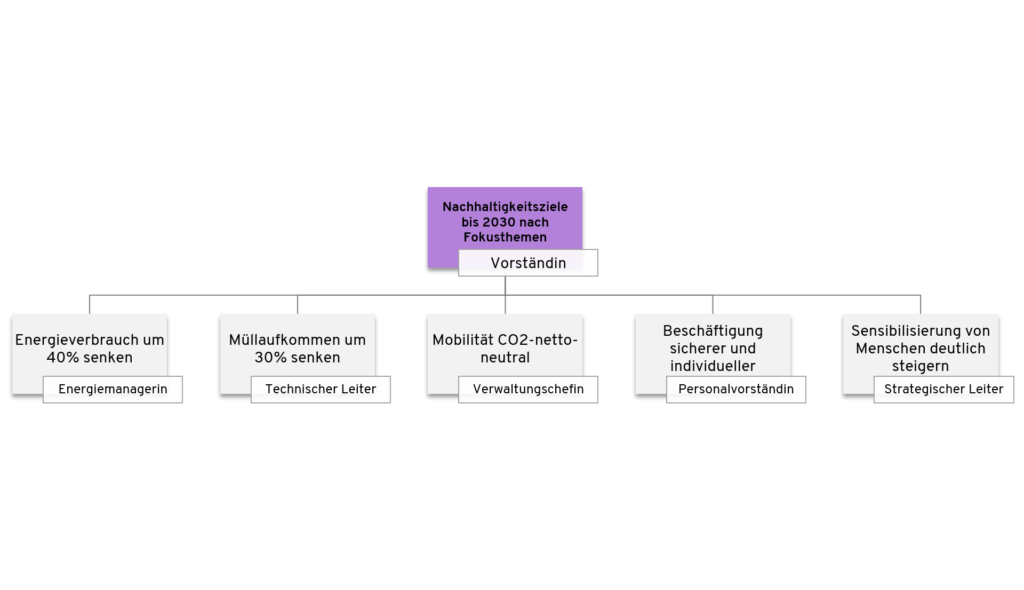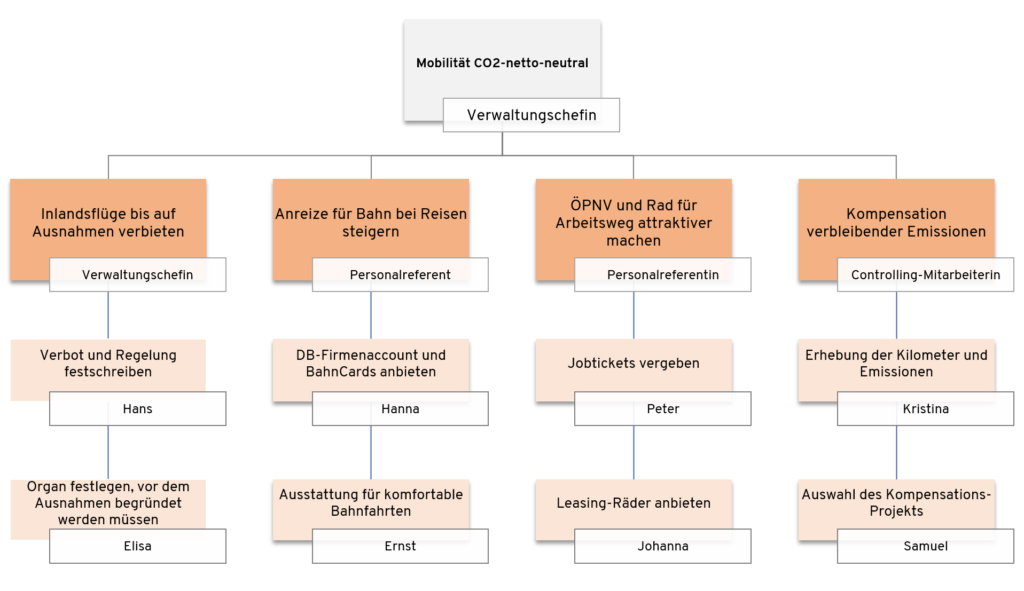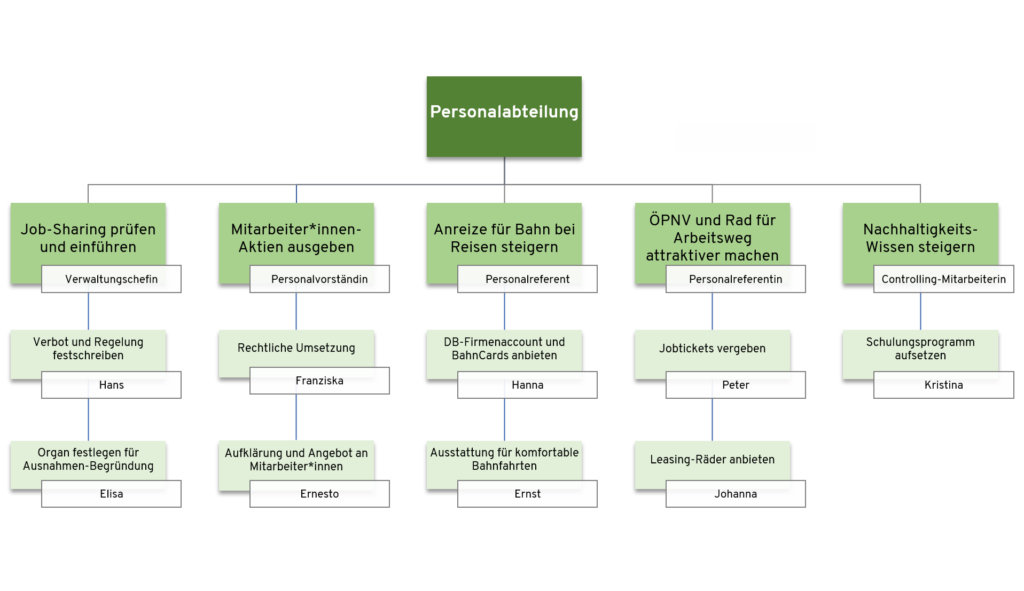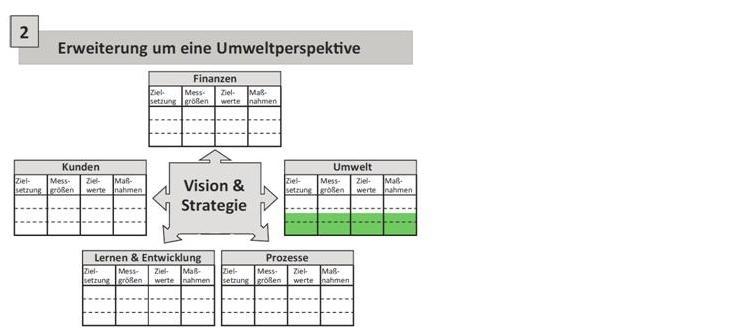Implementing a sustainability strategy is often even more complex than with other strategies. Ideally, more stakeholders need to be involved and the range of problem areas to be addressed is usually more diverse. In addition, social, political and natural conditions are currently changing very quickly. Therefore, the sustainability strategy must also be adaptive in its implementation.
After the Article on the development of a sustainability strategy we want to take a closer look at a few aspects. Parts of this article are actually still part of the development of the strategy, but we wanted to keep the focus. And other parts of this article are primarily useful tips to help with implementation.
We have also summarised our experiences of implementing a sustainability strategy and described typical stumbling blocks.
An overview of all sustainability strategy topics can be found in our Comprehensive guide to sustainability strategy.
Content of the article
- Setting sustainability goals correctly
- Success factors for implementation
- Anchoring responsibilities effectively
- Sustainability controlling right from the start
- Communicative support for the sustainability strategy
- Building knowledge and expertise for sustainability
- Preparing the update of the sustainability strategy
- Frequent stumbling blocks in the implementation of the sustainability strategy

1. set up sustainability goals correctly
In the last article, we only roughly discussed the creation of sustainability goals. Now we want to explain in more detail what options are available.
The special thing about sustainability goals is that they can cover many different topics and areas of the company. Similar to digitalisation processes, the majority of all departments must be involved. In addition, the variety of topics ranges from resource savings to human rights in the supply chain to gender equality in the company.
In order to remedy this complexity, we have previous article describes how to develop focus topics and fields of action. These also help to structure the objectives.
By focus topics, we mean which sustainability topics are really relevant for a company individually. In other words, which topics have a particularly strong impact on the environment or society. Or the issues on which it is under particularly great public pressure to act. For some companies, this could be water consumption and fair pay along the supply chain, while for others it could be climate emissions and gender equality.
Steps in setting up the target
It has proved practicable to proceed in three steps:
- First draft of the targets for the upper target levels
- Structuring the sustainability goals
- Formulation of the objectives
First draft
The first step is to set focus topic targets for the entire company. These should be based on how ambitiously (and to what depth) the company wants to move forward in the focus topic. The sustainability goals should be just as tangible and concrete as strategic corporate goals.
To ensure that the goals for the focus topics are really concrete, it often helps to determine the purpose of the goals:
- What impact should be achieved on the environment or society? For example, CO2 reduction, a self-determined life for workers in the supply chain or making parenthood possible for our own employees.
- What effect should be achieved for the company? For example, the identification and motivation of employees or competitiveness.
In the simplest case, the goals simply contain their purpose in addition. For example:
- Reduce our CO2 emissions by 80% by 2030 by reducing our energy consumption.
- By 2030, promote a self-determined life for workers in our supply chain by supporting suppliers to be certified to labour standard XYZ.
These two examples show the difficulty of sustainability goals. This is because there will always be different ways to achieve a goal and it is often not clear at the beginning which one is the best. If the purpose of the goal is anchored, it is easier to conduct an honest review.
This creates an initial structure of the sustainability goals, e.g. in the form of a target tree.

Structuring the sustainability goals
In the second step, the company derives the sub-goals for the first level of the fields of action from these goals for the focus topics. These fields of action are usually orientated towards the company divisions. For example, production, purchasing and supply chain, marketing, administration, research and development, etc.
Important: The following structure for the objectives should always be based on the actual structures in the company! It is counterproductive to create parallel structures.
From there, the objectives are broken down to the underlying departments and teams. Ideally, this is done by the departments themselves. They should work out which goals they need to set for the area of action or the department in order to support the goal of the respective focus topic.
The development of objectives by working groups instead of by management also ensures that employees identify more strongly with the objectives and the strategy.
Now all the objectives of the departments together result in one objective tree per focus topic.

Formulation of the objectives
The proposed objectives of the fields of action are summarised and reviewed:
- Do the objectives together achieve the overarching goal of the focus topic?
- Are there no conflicts between the objectives?
- Do the targets remain below the planned resources for realisation?
- Are all goals formulated SMART? (Link to the SMART goals method)
A revised version is then sent back to the working groups, which are then asked to check and adapt it for feasibility.
Our experience also shows that companies should plan buffers to achieve their targets. For example, the "climate neutral by 2030" target should be planned so that climate neutrality is achieved by 2028. This way, the target can be met despite uncertainties.
The resulting final target tree serves as an important tool for all areas to achieve the sustainability targets.
For ease of use, a separate target tree can also be set up for each field of action, which maps all focus topics.


Do you want to get out of your comfort zone and into the transformation?
Ask me for a free information meeting.
I am ready with advice and pleasure.
Toni Koç
Sustainability strategy and reporting topics
2. success factors for implementation
When implementing a sustainability strategy, necessary changes occur time and again. If the following factors are kept in mind, as in good project management, implementation will be much easier.
The starting point should be that sustainable development is a dynamic process. New findings will emerge with every step. And these should be taken into account in the further implementation of the sustainability strategy. However, this should not be seen as an endeavour, but as a process in which new paths are constantly opening up constructively with a great deal of curiosity and conviction.
Resources
What human and financial resources have been planned for the implementation of the strategy? How will the resources required for the individual focus topics and areas change? It is then necessary to adapt the measures so that, for example, the goal can still be achieved despite fewer resources.
Systems and processes
What fixed or informal processes take place in the company? Which systems already exist in the company? These can be management systems, communication systems or other systems. The implementation of the sustainability strategy should utilise existing systems and processes whenever possible. This is because setting up new structures will usually lead to "frictional losses".
Participation
The implementation of a sustainability strategy often depends on it being supported by as many employees as possible. In the course of the process, it is therefore important to reflect again and again on how implementation can be placed even more strongly in the hands of many. In this way, they make it "their sustainability" and a permanent anchoring is ensured.
In addition, a wide range of external stakeholders can be involved. On the one hand, this strengthens the legitimisation of the sustainability strategy. On the other hand, the expertise and requirements are integrated in such a way that the strategy can become even more effective.
Corporate culture
What is the corporate culture in the organisation? Sustainability is a wide-ranging topic and will therefore have many points of contact with the corporate culture. In many small or even larger processes, it is necessary to negotiate which aspects of Corporate culture Sustainability can utilise for its success. But also where the corporate culture may hinder sustainability.
Role models
Experience and research show that change processes depend on company management acting as a role model. In addition to measures to implement the sustainability strategy, attention must also be paid to ensuring that management itself takes on tasks or implements changes.
Endurance
Especially if sustainability is a relatively new topic for a company, it will take a long time for everyone to get to grips with it. Setbacks and difficulties will often have to be accepted. This is why it helps to create processes or a culture that constantly motivates those implementing the programme and encourages them to persevere.

3. distribute responsibilities for implementing the sustainability strategy well
There are two types of responsibilities for implementation.
Firstly, those responsible for the targets themselves. A clear structure of the sustainability goals means that these responsibilities can already be well defined at every level of the company. It is particularly important that the company management is involved in the responsibilities so that it can act as a role model.
Secondly, the implementation of a sustainability strategy should establish more general responsibilities. This institutionalises sustainability within the company and gives it a voice. Possibilities for this include the following:
- Sustainability working groups that contribute new ideas and often area-specific opportunities for improvement.
- A sustainability manager who keeps an eye on the overall development of sustainability.
- A sustainability council that serves as a corrective and keeps a critical eye on implementation.
- External assessors for voluntary commitments such as seals or certifications.
4. sustainability controlling from the outset
Good sustainability controlling is essential if a company really wants to become more sustainable. With a sustainability strategy, companies should therefore also establish sustainability controlling and start collecting information and making adjustments at an early stage.
The fundamental aim of sustainability controlling is to be able to provide information on all three dimensions of sustainability: Society, ecology and economy. Economic information can already be found in "classic controlling". Nevertheless, it can be particularly exciting to scrutinise what new economic information is added when the ecological and social effects are considered more closely. In particular, the collection and management of environmental and social information is new for many companies. Here, too, expertise needs to be built up over time in order to understand which data is relevant for what.
Special features of sustainability controlling and the sustainability balanced scorecard
An important special feature of sustainability controlling is that the impact should always be kept in mind. Many data such as resource consumption, minimum wages, etc. only provide indirect information about the extent of the impact on ecosystems or good working conditions. Sustainability controllers must therefore regularly scrutinise whether the impact is well represented by the available data.
A common instrument for sustainability controlling is the Sustainability Balanced Scorecard. This is from the Balanced Scorecard (BSC) according to Kaplan and Norton derived. In addition to the four conventional economic aspects, it now also includes ecological and social aspects. The ecological and social aspects can be
- either be incorporated into each of the four conventional aspects,
- be included as a separate extended perspective or
- form its own balanced scorecard.

The objectives of sustainability controlling therefore include
- Managing the improvement of the impact on the environment and society.
- Managing the impact of sustainability activities on corporate success.
- Gain a better understanding of the interrelationships between individual aspects of sustainability.
- Gain a better understanding of the company's relationships with social, environmental and economic stakeholders.
- Keeping an eye on and promoting those processes that are built around sustainability issues.
Methods and best practice for sustainability in your mailbox

5. communicative support for more effective implementation of the sustainability strategy
An important factor in implementing the sustainability strategy is the right communication. This can run in two directions:
- Internal company communication for better implementation of the sustainability strategy.
- External communication in order to obtain added corporate value from sustainability efforts.
- External communication to involve stakeholders and improve implementation.
Internal corporate sustainability communication
Good communication within the company ensures that employees are aware of the sustainability goals and measures. Only then can they identify with them in the first place and thus participate in their implementation. Internal sustainability communication can work at various levels:
- Inform stakeholders about their responsibilities with regard to sustainability.
- To get employees to realise the relevance of sustainability for the company.
- Involve those involved in the continuous search for solutions.
- Generating motivation for sustainability and sustainability a topic of conversation within the company.
- Generate motivation for the process and progress.
External sustainability communication
Externally, good communication can reinforce the implementation of the sustainability strategy by generating added business value. Sustainability communication can contribute to various objectives:
- image building,
- employer attractiveness,
- to attract new customer groups,
- for the identification of new suppliers or
- for differentiation from competitors.
However, all of this can only be realised if the communication is truly authentic.
On the other hand, sustainability communication can be used to involve indirect stakeholders such as fans, industry associations, NGOs, governments or completely different actors.
A sustainability communication campaign
Both internal and external communication can be integrated into existing communication. For many companies, however, it also makes sense to set up their own long-term campaign for sustainability efforts. The aim here is to emphasise sustainability, but also to increase identification with these efforts. Bold "company goes green" campaigns have long since given way to this. Today's campaigns are characterised by authenticity and tangibility.
Sustainability communication campaigns can therefore pursue various objectives:
- Provide clear communication and orientation on the complex topic of sustainability.
- Provide a contact point for employees and external parties for queries and ideas.
- identification with the sustainability strategy, regardless of the company's "sustainability past".
- Enable clearer responsibilities for sustainability communication and thus also more standardised communication.
- Transparent and authentic communication on sustainability issues is easier if it is separated from other (e.g. sales) communications. Authentic communication is a core success factor for sustainability communication.
- Establish honesty and communicate where there are still construction sites and where you are looking for solutions. This creates trust, allies and authenticity.
6. expanding knowledge and expertise for sustainability
We have already written about this in various places: Sustainability can only be implemented effectively if as many employees as possible are involved. To do this, they need elementary qualities:
- You must be motivated. Sustainability must be an important and ideally fulfilling topic for them.
- You must be able to. They need knowledge about sustainability in general and about ways to implement it.
Both motivation and ability can be achieved through knowledge transfer. The field of "Education for Sustainable Development" (ESD) has been growing for several years and there are always new methods for imparting knowledge.
Basically, the more employees gain knowledge about sustainability, the better the sustainability strategy can be implemented. Each company should decide individually which form of knowledge transfer is the right one. The options are as follows:
- Sustainability training courses and seminars
- Micro-learning and online learning programmes on sustainability
- Promotion of employee involvement in sustainability initiatives
- Internal dialogue rounds on sustainability (greenbag sessions based on the brownbag sessions)
- Exchange rounds with other companies
- Further training or extra-occupational studies on sustainability for employees
Promoting knowledge and expertise among suppliers and partners
Companies often face particular difficulties when they are unable to find sustainable suppliers or other partners. Or when good relationships with existing partners are to be maintained, but these have little to do with sustainability. For many companies, the best way was to motivate and empower these partners to become more sustainable.
VAUDE reported that it was important for them to actively train suppliers and support them in implementing sustainability more strongly.
7. prepare the update of the sustainability strategy
With the implementation of the sustainability strategy, the company should simultaneously begin preparations for the update. New findings and experience will be available for the development of the subsequent sustainability strategy. These form the basis for well-founded decisions.
In particular, however, parallel to implementation, consideration should be given to how the next strategy can be even more well-founded. What figures, trends and analyses should it be based on? Companies often lack a solid data basis for developing an effective sustainability strategy. Creating a detailed carbon footprint, for example, can be the ideal data basis for a climate strategy. It is just as important to establish a close relationship with stakeholders in order to involve them in the development of the upcoming strategy.

8. stumbling blocks in the implementation of a sustainability strategy
In the course of the projects, we have collected typical stumbling blocks in the implementation of sustainability strategies. Here is the list of the most common hurdles.
- The employees find No identification with the sustainability strategy and it comes "out of the blue" for them.
- The employees do not know about their tasks with regard to the sustainability strategy and have no orientation.
- The employees Lack of (methodological and technical) knowledge to implement the sustainability strategy.
- The Management does not live the sustainability goals and makes the strategy so inauthentic.
- The Communication focusses only on successeswithout addressing hurdles. It therefore runs the risk of appearing inauthentic or even greenwashing.
- The customers and others Stakeholders are not consulted and they don't know where the commitment to sustainability comes from.
- The Sustainability progress is not measured. In this way, neither a goal alignment can take place nor the motivation to continue can be increased.
- It is used generically to a wide variety of sustainability topics worked. Instead, the topics with the greatest impact should be clearly identified.
- The Sustainability goals are not ambitious enough and the efforts are not perceived as serious.
- Conflicting objectives have not been resolved and there is no time available to complete the tasks, for example.

Do you want to get out of your comfort zone and into the transformation?
Ask me for a free information meeting.
I am ready with advice and pleasure.
Toni Koç
Sustainability strategy and reporting topics

2 comments
Comments are closed.